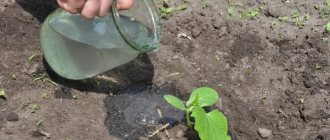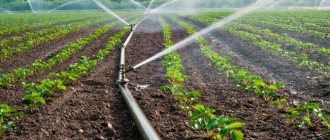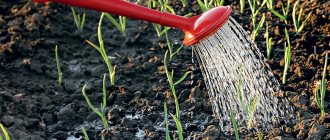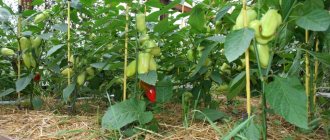Watering cabbage is the basis for cultivating all varieties of this vegetable crop. If the seedlings are successful and have taken root, then further success depends on the soil moisture regime. And on some types of soil, the importance of proper watering of different types of cabbage in open ground increases. The fact is that the poorly developed superficial root system of the popular vegetable crop is not capable of extracting moisture from the deep layers of the soil. Drying out of the top layer of soil in dry, hot weather is dangerous for developing heads of cabbage. Without figuring out how to properly water cabbage in open ground, a gardener risks being left without a harvest.
Frequency and intensity of watering
With the correct frequency of watering, the heads of cabbage do not crack, and the taste of the vegetable improves. We will consider separately what factors should be taken into account when calculating the optimal frequency and intensity of irrigation.
Development period
Watering cabbage should be adjusted depending on the period of its development:
- After planting seedlings in open ground. Seedlings need to be planted in wet soil with a humidity of 80%. To do this, it must first be moistened at the rate of 10-15 liters of water per 1 square meter. m. In open ground, seedlings need to be watered for the first time a day after planting. The optimal intensity of irrigation for seedlings is about 2-3 liters per bush or 8 liters per 1 square meter. m. Water the cabbage once every 3 days for 2-3 weeks.
- After strengthening the plant. Stronger plantings need to be watered more moderately - about 2 times a week at the rate of 12 liters of water per 1 square meter. m. In arid hot climates, large-fruited cabbage varieties should be watered at the rate of 7-8 liters per bush.
- At the stage of tying the forks. During this period, cabbage leaves are actively growing and heads of cabbage are forming, so it needs abundant watering - approximately 10 liters of water per plant (20-30 liters per 1 sq. m, and in drought - up to 40-50 liters).
2-3 weeks before harvest, cabbage no longer needs moisture, so watering should be stopped. In the case of late varieties, this must be done a month before cutting the heads, otherwise they will crack, which will significantly affect their shelf life.
Regardless of the stage of development, moisture must be supplied to the plant steadily, otherwise it will certainly affect the vegetable. For example, if cabbage experiences a lack of water at the stage of head formation, then in the future its inner leaves will actively grow, and the outer ones will tear. In turn, this will lead to the appearance of cracks.
Ripening period
When watering cabbage, you also need to consider what varieties it belongs to:
- Early. Such varieties need to be watered more abundantly than others, especially in June. Water consumption – up to 20-25 liters per 1 sq. m. Soil moisture should be maintained at a level of at least 80-90%. The frequency of watering is 2 days after planting and at intervals of 8-10 days thereafter.
- Mid-season, late. These varieties of cabbage require good watering during mass ripening of the forks. This stage occurs in August, so it is during this period that watering should be plentiful so that the soil moisture does not fall below 75-80%. The frequency of watering is as follows: 1 time - on the day of planting;
- 2 times - a week after the first;
- 3-5 times – at the stage of rosette formation;
- 6-8 times – at the stage of head formation;
- 9 and 10 times - when the heads of cabbage reach technical ripeness.
Soil type
If all the watering rules are followed, but the cabbage still begins to crack, you may need to take a closer look at the soil on which it grows. The type of soil can be determined experimentally by rolling a ball out of it and then pressing on it:
- If you can easily roll a ball out of the ground, which collapses when pressed, most likely the garden has light loamy soils. This means that cabbage requires more frequent watering.
- If the rolled ball turns into a flat cake when pressed and does not crumble, it is likely that heavy loams predominate in the area. Such soil absorbs water very poorly and retains it for a long time, so you need to be careful with watering. It is necessary to loosen the soil after watering or precipitation to improve its air exchange.
- If it is impossible to roll a ball out of the ground, it means that cabbage grows on sandy and sandy loam soils. They instantly absorb any liquid and lose it just as quickly. Therefore, the frequency of watering needs to be increased so that a dry crust does not form on the garden bed.
Climatic conditions
In humid climates where rainfall is common, watering frequency will be lower than in a hot, dry region. In the southern regions, it is necessary to increase not only the frequency of watering, but also the water consumption per bush, since the moisture will evaporate much faster.
In arid climates, for large varieties of cabbage, the optimal water consumption is considered to be 7-8 liters per plant or up to 50 liters per 1 square meter. m. Of course, under no circumstances should the soil be allowed to become too waterlogged. This will lead to the heads of cabbage becoming too loose, losing their transportable qualities and reducing their shelf life.
Liquid fertilizers
In addition to watering with clean water, cabbage also needs liquid fertilizers. It is advisable to feed the plant 3-4 times during the season.
The first feeding is carried out about 20 days after planting the seedlings in a permanent place. It should be aimed at stimulating the formation of green mass (increasing the number of leaves). 0.5 liters of liquid cow manure is diluted in 10 liters of water. About half a liter of nutrient solution is poured under each plant.
The second feeding is carried out 10-12 days after the first. This time, dilute 0.5 liters of mullein (or chicken droppings) in 10 liters of water and add 1 tbsp. l. "Crystalline" or "Solution". Each plant requires about 1 liter of mixture.
The 2 dressings described above are suitable for both early and late varieties of white cabbage. For the latter, 2 more feedings are performed.
Third feeding (2 weeks after the second). Dissolve 2 tbsp in 10 liters of water. l. superphosphate and 1 microelement tablet. Consumption - 6-8 liters for each plant.
The final liquid feeding is applied in August. For 10 liters of water take 1 tbsp. l. nitrophoska. At the same time, the heads of cabbage are dusted with wood ash at the rate of 1 glass of crushed ash per 1 m2.
In this article we will answer the question: How to grow cabbage correctly?
Proper care of cabbage after planting.
How and in what quantities cabbage is fertilized
Further care of cabbage plantings consists of fertilizing, watering, hilling the plants, loosening the rows and comprehensive protection from pests and diseases. 10-14 days after planting the seedlings, the first fertilizing is carried out with a 0.5% solution of ammonium nitrate or liquid organic fertilizers: mullein diluted with water (5:1) or bird droppings (10:1) 1.0-1.5 l each per plant. Fertilizer is applied carefully so that it does not get on the leaves and cause burns. After fertilizing, be sure to loosen the soil in the rows and between the rows.
The second feeding is carried out during the period of active growth of the rosette of leaves, 2-3 weeks after the first. You can use a mixture of ammonium nitrate, superphosphate, potassium sulfate in a ratio of 1:2:1, using 40-60 g per 1 m2. Nitrophoska is added in the same dose. Organo-mineral fertilizing is good, in which the dose of nitrogen mineral fertilizers is reduced.
The third feeding is carried out if necessary, if the plants are still underdeveloped, but not earlier than 2 weeks after the second. Use a mixture of superphosphate and potassium sulfate (2:1) or wood ash at the rate of 30 g per plant. The earth is loosened in rows, the plants, if possible, are hilled, sprinkling the stems with earth up to the rosette leaves.
There are some peculiarities in the nutrition of late cabbage intended for winter storage: potassium should prevail over nitrogen and phosphorus. This helps reduce storage losses.
Watering cabbage
Water the cabbage as needed. It is more economical to water in holes near plants early in the morning or in the evening. As soon as the soil dries out after watering, it is loosened. The greatest need for water occurs during the period of active growth of the rosette of leaves and the formation of heads of cabbage. If during this period there is hot, dry weather, it is necessary to give up to 10 liters of water per plant or 20-30 liters per 1 m2 per 1 watering, and in case of prolonged drought up to 40-50 liters. Do not water abundantly after a long drought. This leads to cracking of the heads of cabbage. If there is heavy rain during head formation after a drought, the roots of the plants are trimmed slightly with a shovel to reduce water absorption.
Before the rosette of leaves closes after rain or watering, hilling is carried out: 1-2 for early and medium varieties and 2-3 for late varieties. This technique causes additional roots to grow. Spud only with damp, not dry, soil. If the rosettes of leaves have already closed between the rows, then this operation must be carried out very carefully, because plants can be damaged.
Is it possible to water cabbage from above? How to water cabbage correctly?
Cabbage is a moisture-loving crop, when growing which the soil should not be allowed to dry out. For early varieties, the optimal humidity is 80%, for late varieties - 75%. Early varieties especially suffer from lack of moisture.
Watering cabbage according to the growing season
At the early stage of the growing season, right up to the beginning and during the formation of heads of cabbage, cabbage of any type is watered very intensively - every other day, and in some cases, young cabbage seedlings require daily watering. It all depends on weather conditions, for example, during the dry period, seedlings are watered once a day, and during periods of prolonged rains, the water supply is reduced to once every 2–4 days.
To save time, instead of daily watering, you can sprinkle the cabbage for 2 to 3 hours.
On average, watering cabbage in the central regions is carried out once every 5–7 days, in the southern regions once every two days. The frequency of watering also depends on the variety. So, early varieties need the most moisture in June, and late varieties need the most moisture in August.
Early cabbage is watered 2 days after planting the seedlings, late cabbage is watered on the day of transplantation, and then 5 to 8 days later. This time is needed for the rooting of seedlings. The last time the early varieties are given moisture is 2 weeks before the heads of cabbage are harvested; for late-ripening cabbage, watering stops a month before harvest.
During the formation of heads of cabbage, up to 12 liters of liquid/m2 are added under the cabbage; the rest of the time, 7–8 liters/m2 is sufficient. If during the head formation stage watering was less intense than before and after this period, the inner leaves of the cabbage will begin to actively grow, which will lead to cracking of the heads. Watering should be done regularly at equal intervals, maintaining the norms of the supplied water.
On a note! Excess moisture does not benefit cabbage. Heads of cabbage have a reduced shelf life and a deteriorating ability to withstand transportation well.
According to the type of soil on the site
It is known that dense soils are prone to stagnation of moisture; light soil mixtures absorb water well, but retain it poorly. Accordingly, on dense soils the number of waterings and frequency are reduced; on light soils, cabbage will need more water, and the intervals between waterings will be shorter.
Cabbage grows better in nutritious and loose soils, where there is an influx of oxygen and gas exchange processes proceed normally. Acidic soils are contraindicated for this crop; before planting seeds or transplanting seedlings, the soil is limed with dolomite flour or agrochalk.
Before planting, the soil can be amended. Clay soils are cold and dense; when compressed into a ball, such soil does not crumble. Humus is added to such areas, which when processed by microorganisms into humus gives heat, ash and a little sand are added. For 10 m2 you will need 30 kg of humus, 2 ten-liter buckets of ash and the same amount of sand. Embed all components into the top layer of soil in the fall.
Sandy soils lack nutrients and natural humus and are too light. The sandstones are weighted with peat, and the lack of nutrition is compensated by a mixture of chernozem and humus. Humus can be replaced with rotted compost from clean plant residues. On sandstones, for every 10 m2 in spring and autumn you will need 2 buckets of humus and chernozem and 1 bucket of peat.
On dense peat bogs and swampy soils, water turns from a friend into the main enemy of cabbage. Ideally, in such areas, drainage is first constructed in the form of ditches filled with pebbles and branches. Then the ditches are filled with fertile soil mixed with humus. Cabbage beds are placed above the ditches.
If there is no time to do drainage, then per 10 m2 of cabbage beds add 2 buckets of sand and fertile soil, as well as 1 bucket of vegetable compost and ash. Dense soils are acidic, and ash deoxidizes the soil. The beds must be made high to eliminate moisture stagnation.
Watering and type of cabbage
Not only white cabbage consumes a lot of moisture. Broccoli loves water no less; this species is hydrated at the rate of 15 liters of liquid per week. When watering, the soil should be wet to a depth of at least 40–45 cm.
Cauliflower needs a little less moisture, approximately 10 liters per week, but weather factors must be taken into account. In hot weather, broccoli and cauliflower are watered up to 3-4 times a week.
Chinese cabbage is a fast-ripening species, so watering should be carried out systematically at regular intervals. The “Beijing” plant especially loves sprinkling with warm water; in addition, such a shower will rid the plant of cruciferous flea beetle.
White cabbage requires up to 1 liter of liquid per plant before the formation of heads of cabbage; during the period of head formation, the norm is increased to 2.5 liters - 3 liters, and during the period of active growth of the aerial part, about 4 liters are given for each plant.
The best varieties
There are many varieties of cabbage. Only 432 varieties of white cabbage are registered in the Russian state register.
The length of the cabbage growing season can vary. For early ripening plants it is 70-130 days, for medium ripening plants it is from 125 to 170 days, for late ripening plants it is from 153 to 253 days.
Malachite
It is worth paying attention to the following early ripening varieties:
- June is a time-tested variety. The heads of cabbage are medium-sized, weighing up to 2.5 kg, loose, and not prone to cracking. Grows well on loamy soils.
- Malachite is a representative of white cabbage. Very early. The weight of the heads does not exceed 2 kg. The head of cabbage is dense.
Medium-ripening cabbage gives a higher yield, the heads of cabbage are dense, lighter inside. The most popular varieties:
- Gribovskaya 231 is a very undemanding variety when it comes to soil; it produces a good harvest even on sandy soils. Grows excellently in the central European part of Russia and in arid regions. The average weight of heads of cabbage is about 2 kg. Suitable for fermentation.
- Siberian - a variety created for the northern regions. It performs well in Karelia, Sakhalin and Kamchatka, and Western Siberia, as the plants can easily tolerate low temperatures. Ripening can last up to 140 days. The average weight of one head of cabbage is 4 kg. Does not crack, transports well. From 1 m² you can harvest 11 kg of crop.
Eastern horoscope of the Pig (Pig) for 2021 (Earth, Metal, Water, Fire, Wood)
Late-ripening varieties are the most shelf-stable and dense. Huge heads of cabbage are stored for a long time without loss of quality and retain all useful components well: vitamins, trace elements and minerals. Among them are:
- Moscow late is one of the best varieties. The heads of cabbage are very large, some weighing from 8 to 10 kg. The rosette is large and spreading. The variety is resistant to various diseases; plants can tolerate frosts down to -5°C. With properly organized storage, the fruits last until the next harvest.
- Amager is a variety suitable for industrial cultivation. The rosette is semi-spreading, the leaves are bluish-green, with a waxy coating, their edges are wavy. Heads of cabbage grow up to 4 kg. On average, the yield is up to 6 kg/m². Easy to transport. Taste qualities gradually increase during storage.
Does cabbage like watering and why does it need to be watered regularly?
This vegetable crop needs constant watering. Only with sufficient moisture can cabbage develop well and produce large heads of cabbage and juicy leaves. Cauliflower also grows well and absorbs juices with sufficient moisture.
Important! If the plant is not given enough water, it will stunt its growth and the heads will not grow. Gardeners, if possible, arrange drip irrigation for cabbage
However, you can create a special drip irrigation yourself, for example, from plastic bottles. It is not difficult to make, but usually it is not used for cabbage. Basically, this watering method is used for tomatoes, cucumbers and peppers. Often gardeners simply cover cabbage beds with mulch.
Gardeners, if possible, arrange drip irrigation for cabbage. However, you can create a special drip irrigation yourself, for example, from plastic bottles. It is not difficult to make, but usually it is not used for cabbage. Basically, this watering method is used for tomatoes, cucumbers and peppers. Often gardeners simply cover cabbage beds with mulch.
Tips on how to properly water cabbage in open ground
Cabbage is a moisture-loving plant, which is explained by its shallow roots and large transpiring surface of the leaves. It consumes the most water when the head of cabbage is just setting, so at this time the soil moisture should be at least 80%. There are three main methods of moistening the soil in which cabbage grows:
- Watering in furrows.
- Drip irrigation.
- Sprinkling.
It is recommended to water the furrows with a hose when the plant is already strong, but this type is not suitable for irrigating young bushes - for them it is recommended to apply water directly to the root zone. Drip irrigation is more effective when water is supplied in small portions. This method ensures that optimal soil moisture is maintained throughout the ripening of cabbage. The disadvantage is the high cost of installation and the possibility of waterlogging the ground. You can see what a drip irrigation system looks like in numerous photos on the Internet.
The sprinkling method is the most optimal choice of watering for cabbage, because in this case not only the soil, but also the ground layer of air is moistened. Irrigation of the land occurs with the help of special rain installations, which can regulate irrigation rates over a wide range. This method reduces the possibility of waterlogging and waterlogging of the ground. Another advantage is that, together with water, you can apply foliar fertilizing and combine soil moisture with spraying with preparations that destroy pests.
Suitable water temperature for irrigation
For growing cabbage in open ground, the temperature of the water when watering is very important. Plants in the open ground should be moistened with heated or settled water in special containers that should be placed on the site. To make the heating process faster in the fall and spring, it is better to paint the containers in a dark color. The optimal water temperature when watering cabbage in open ground is 18-23 degrees. Water colder than 12 degrees will be destructive for all varieties of white cabbage.
How often and when to water cabbage
The frequency of watering cruciferous plants in open ground depends on the area in which the plant is cultivated. If the climate is rainy, then frequent moistening is not advisable to prevent waterlogging of the soil. During drought, the liquid evaporates instantly, so watering should be done more often. Immediately after planting, seedlings should be watered every 3 days with 8 l/sq. m. In the future, the average watering rate is 2 times weekly at the rate of 12 l/sq.m.
Early varieties of white cabbage are recommended to be watered more intensively in June, while late varieties need more moisture in August, when the head formation stage occurs. The best time to moisten the soil is morning and evening. If the weather is dry, you should not wait for the soil to dry out, and water twice as often as average. You can distribute water in doses using a watering can if drip or rain irrigation systems are not installed on the site. Watch the video in which an experienced gardener gives practical advice on watering cabbage:
Top dressing
A good harvest awaits the gardener who not only knows how to properly water the plants, but also how to feed them. It is advisable to fertilize cabbage throughout the entire growing season, and start from the moment the seedlings are grown. To feed, you need to make the following fertilizer: dilute 40 g of superphosphate, 25 g of ammonia, 10 g of potassium chloride into a bucket of water. This solution needs to be fed to the plants 14 days after picking. After another 2 weeks, it is necessary to re-feed, for which 35 g of ammonium nitrate and 10 liters of water are taken.
After planting the cabbage in open ground, a third feeding is carried out: 80 g of superphosphate, 30 g of ammonium nitrate, 20 g of potassium chloride are diluted in a bucket of water. The plants should be fed for the last time 14 days after planting. During this period, it is recommended to fertilize it with mullein or chicken droppings, which will provide the seedlings with the necessary nutrients. To do this, dissolve 500 g of fertilizer in a bucket of water and pour 1 liter into each well. Some gardeners fertilize cabbage with ash, for which they dilute 1 glass per bucket of water.
Methods of moisturizing
Today, gardeners most often use three methods of watering cabbage in open ground:
- along the furrows;
- drip;
- sprinkling.
Let's look at all these watering options in more detail.
Along the furrows
This method applies only to already established plants; it is not suitable for young seedlings. This limitation is due to the fact that it is important for young cabbage to supply moisture directly to the root, and this method of watering cannot provide this.
Drip
This irrigation option is more economical and efficient than the previous one. In this case, water is supplied frequently, but in small portions: this ensures constant soil moisture at the optimal level.
The disadvantage of the drip method is the high cost of installation, as well as the sometimes possible waterlogging of the soil. But how to plant and grow cauliflower, and what you should pay attention to, is indicated here.
Sprinkling
This method requires special installations that carry out watering at a given time and using a certain amount of water. Since the amount of water is set initially, the sprinkling method completely eliminates the possibility of waterlogging (unless the gardener himself makes a mistake).
The great advantage of this method is the ability to simultaneously add fertilizer for cabbage along with watering, as well as add special insecticidal and fungicidal substances to the water.
Watering schedule during the growing season
Each cabbage variety goes through its development phases at different times and, accordingly, the intensity of irrigation changes. Early varieties require more moisture at the beginning of summer, late-ripening varieties require more moisture in August, so the watering schedule is built taking into account both the varietal characteristics of the plant and weather factors. Gardeners often ask whether cabbage should be watered after rain. Minor precipitation does not affect the timing of irrigation and water consumption. Rain of moderate intensity shifts watering by 3–7 days, and a prolonged downpour completely replaces it.
First shoots
When sowing in open ground, the weak root system of sprouts greatly depends on the composition of the soil and its ability to retain moisture. For the first 2–3 weeks, sprouts on sandy soils need to be watered every 2–3 days, while on heavier and denser loams it is sufficient to irrigate once every 4–5 days. If necessary, you can combine watering with fertilizing.
Did you know? The stem of cabbage is the stalk, and the head
—
This is a huge wintering bud.
After disembarkation
With the seedling method of growing, the sprouts are watered abundantly in the holes when planting. After this, the first irrigation is carried out after 5–6 days. During the growth of leaves before the formation of forks, cabbage is watered on average 4–6 times a week in temperate climates and up to 10 times in the southern regions.
During the formation period
Moisture is especially necessary when forks are setting and growing. At this time, the soil should be shed to a depth of 40 cm. But irrigation during this period should be especially uniform and constant. If you allow the soil to dry out and then water it abundantly, the inner leaves of the head of cabbage will begin to grow faster and tear the upper ones, as a result of which the entire crop will lose its presentation.
Water requirements
Cabbage is sensitive and demanding regarding water parameters . Incorrect fluid temperature can cause undesirable consequences. Watering with cold water leads to diseases, improper development of individual organs, death of too young plants, etc. Moreover, maintaining the temperature regime of watering will be important both at the stage of seedlings and at the stage of plantings already planted in open ground.
Therefore, starting with seedlings, let’s make it a rule to take water for irrigation only at a certain temperature - from 18°C to 23°C . This is the so-called “room temperature”. You can achieve these parameters by pouring water for irrigation from the tap into buckets in advance so that it warms up normally. It is important that the liquid does not overheat, since watering with hot water is also undesirable .
By stocking up on water in advance, you will observe another important parameter - water only with settled water. Distilled water and water from reservoirs are also suitable for irrigation.
Watering cabbage with ammonia
Pests attack the crop from the beginning of growing seedlings until ripening. The succulent leaves attract insects; caterpillars, slugs and mole crickets are not averse to feasting on it.
A one-time treatment of cabbage will not completely get rid of harmful insects; it must be repeated several times, the number of sprays depends on the degree of damage. You can achieve the desired result only by carefully following the recommendations.
Ammonia is a medical preparation and has a pungent, unpleasant odor. With its help, you can bring a person to his senses, induce a gag reflex, and it is also used for neuralgia.
In the garden, ammonia can be sprayed on most cultivated plants, including cabbage. It saturates the soil with nitrogen and helps cope with insect attacks. You can purchase ammonia at a private or public pharmacy.
Before use, ammonia is diluted in accordance with the recommendations, this is done very carefully. Excessive amounts of the substance threaten the accumulation of nitrates in cabbage, and sometimes can even destroy the crop.
Use it for root feeding or spraying the ground part
Excessive amounts of the substance threaten the accumulation of nitrates in cabbage, and sometimes can even destroy the crop. It is used for root feeding or spraying of the ground part.
Feeding is carried out in the following quantities:
- To enrich the soil - 50 ml of ammonia per 10 liters of water. Water the area 2 weeks before planting the cabbage in the ground, recommended for nitrogen-poor soil.
- As a root fertilizer - 6 tablespoons of the substance are added to 10 liters of water and generously poured under each bush after the main watering. The procedure is carried out once a week.
Such feeding is needed for weak plants experiencing mineral starvation. Watering is carried out at the beginning of summer, when the seedlings gain strength and grow intensively.
Procedure:
First, prepare the solution, observing the proportions. Pour it into a sprayer with small drops. Carefully process the plantings, capturing the entire above-ground part of the plant, paying special attention to the back side of the leaves. Repeat the procedure, if necessary, after 7-14 days.
How often
In addition to what kind of water should be used to water cabbage, many gardeners are concerned with the question of how often this should be done. After all, untimely watering is fraught with many negative consequences and can even lead to the death of planted seedlings or an already mature plant. At the same time, different varieties of cabbage (white cabbage, cauliflower, red cabbage, etc.) may have some differences in how often this crop should be watered. But in general, the rules remain the same for all varieties, with minor nuances.
Cabbage's need for water and, accordingly, the frequency of watering is determined by the age of the plant. For seedlings and adult plants, watering is carried out according to different schemes.
Most often, cabbage needs to be watered in the following situations:
- after planting seedlings;
- after the beginning of head formation.
In these situations, it is correct to water the plant several times a day. This must be done when growing white, cauliflower, red and other varieties of cabbage. This intensity persists for a couple of weeks. During the period of growth of deciduous mass, watering and its frequency can be slightly moderated.
But remember that excessive watering, as a rule, causes excessive moisture in the soil, as a result of which the vegetable can begin to rot and will soon die. Root death begins when the plant is in wet soil for more than eight hours.
Very careful watering is necessary during preventive measures aimed at combating diseases or pests. In this case, the plants are treated with special solutions (decoctions of tops, solution with vinegar, etc.). Here it is necessary that the treatment agent remains on the surface of the cabbage for some time. And watering can wash it away, making prevention ineffective. Each plant variety (cabbage, cauliflower, broccoli, etc.) has its own means of combating pests and diseases, but the watering rules remain virtually unchanged.
Also an important aspect for the frequency of watering is the climatic conditions prevailing in the garden plot. In hot weather, watering is carried out more often than in cloudy weather. In this way, you can achieve a perfectly formed head of cabbage even in the arid regions of the country.
In addition, heavy watering of plants before harvesting is not recommended. This can cause cracking of the heads of cabbage. To avoid this, a month before harvesting and before late varieties of cauliflower, white, red, etc. cabbage are fully ripened. Watering should be stopped altogether.
Today there are three irrigation options. Each gardener chooses the one that is most suitable for his garden. You can use them at different periods of the plant’s growing season or try a new method every year to determine the greatest effectiveness specifically for your garden.
So, the methods for watering cabbage (any variety - cauliflower, white, red, etc.) look like this:
- watering as needed. An economical method, which involves watering in the evening or morning in dug holes around the plants. After adding soil, loosening must be carried out here. The highest intensity of watering occurs at the stage of active growth of leaves and formation of heads of cabbage. In this case, for one watering, approximately 10 liters of water should be poured under one plant (20-30 liters per 1 m2, and in drought - up to 40-50 liters);
- depending on the existing climatic conditions. Here, watering is carried out depending on the age of the plant (seedlings, formation period, adult plant). The number of waterings per day is determined by the frequency of rainfall, the number of sunny days and the aridity of the climate;
- depending on the variety. Some cabbage varieties are more demanding on water conditions. Therefore, they need to be watered more often.
Whatever method you choose, hilling is required after watering or rain. This process is carried out until the rosettes of the emerging leaves close. For early varieties (whether colored, red or other types), hilling is carried out 1-2 times, and for late varieties - 2-3 times. This will allow additional roots to form. In this case, hilling is carried out only on damp soil.
It is also worth noting that after planting seedlings in open soil, they are watered with 5-6 liters per 1 m2 every day for two weeks. After two weeks, watering is carried out once, pouring 12 - 15 liters per 1 m2. In addition, it is known that early varieties should be watered more in June, and late varieties in August. 15 liters of water must be poured per 1 m2
Please note that it is better to water cabbage only in the evening, and if necessary, you can do it in the morning
General recommendations
There are some general recommendations that should be followed when organizing cabbage watering:
- When watering the planting, you cannot use a hose with high water pressure, as this will lead to washing out the soil and exposing the roots of the plant.
- You should not overdo it with watering, since excess moisture leads to root rot and also contributes to the formation of loose heads of cabbage. In addition, waterlogging leads to cracking of the heads.
If the plant is in waterlogged soil for more than 8 hours, then irreversible rotting of the root system begins.
- When watering crops, focus on weather conditions. When precipitation occurs, you should wait to water, and in case of severe drought, water the cabbage several times a day, but making sure that the water well saturates the soil in depth and reaches the root system, and does not just wet its surface.
- After moistening, loosen the soil to prevent the formation of a crust on the surface. At the same time, it is also worth removing all weeds.
- Some vegetable growers, noticing that the cabbage leaves are beginning to wither, immediately rush to the watering can and begin to flood the plant. This is a big mistake. The fact is that limp leaves can signal both a lack of water and its excess. To avoid mistakes, be sure to check the condition of the soil before watering.
- When watering, make sure that the soil is deeply saturated with moisture. While the plant is gaining green mass, it will be enough to soak the soil 30 cm deep. When the forks begin to tie, shed the soil more abundantly - 40 cm deep.
- To obtain a head of cabbage weighing 2 kg over the entire period of growth and development, it is necessary to pour up to 200 liters of water under the bush.
- Hill up the cabbage after watering until the leaf rosettes close together. Carry out the procedure only after watering. As a result, many lateral rhizomes are formed, which will have a beneficial effect on the development of the entire bush.
- The ground should be mulched with grass, hay or non-woven black fabric. Thanks to this, the water will evaporate more slowly, so the number of waterings can be reduced. In addition, a layer of mulch will stabilize the soil temperature and also prevent the formation of a hard crust and the germination of weeds.
You can learn how often you need to water cabbage, as well as the nuances and secrets of this process from the video:
Watering cabbage is a fundamentally important agrotechnical technique, on which the production of a rich harvest of elastic and strong heads of cabbage will depend. It should be plentiful and regular, but not excessive. It must be remembered that if there is a lack of moisture, the plant quickly dries out, and if there is too much moisture, it gets sick with black leg and is subject to various fungal infections.
0
0
Copy link
How often to water cabbage
The schedule must be drawn up in advance to prevent deterioration in taste or rotting of the future harvest. You can’t focus only on dry soil. Cabbage has branched roots that go at least 15 cm deep into the soil. It is to this height that the soil should remain moist. It is very difficult to check this with available means.
Depending on the ripening period
It is necessary to water the cabbage immediately after picking the seedlings. In the initial phase of the growing season until the head of cabbage is formed, all varieties are moistened intensively, at least every other day, and sometimes daily. In this case, the irrigation schedule depends on the climatic parameters of the growing region and weather:
- Dry period. If the air temperature is high and there has been no precipitation for a long time, then young seedlings need to be irrigated with water at least once a day so that the soil does not dry out and the plant has enough moisture for growth and development.
- Lingering rains. If precipitation occurs daily or every other day, then watering should be carried out no more than once every 3-4 days. In this case, it is necessary to focus on the condition of the soil. If precipitation is heavy, the ground gets wet to a great depth, moistening can be canceled.
In the southern regions, where the temperature is higher, seedlings and adult plants need to be watered once every 2 days, in the central regions - once a week.
Early varieties are always more moisture-loving, and therefore require a larger volume of liquid in June, which marks the beginning of the growing season. Late species require more moisture at the time of maximum growth - in August. Frequency of water application depending on the ripening period of cabbage:
Early varieties - two days after placing the seedlings in the ground, late varieties - immediately upon planting, again - after 1 week. It is important to do the last watering for early species 10–15 days before harvesting the heads of cabbage, for late ripening species - 30 days.
Different types of cabbage
Watering cabbage depending on the type:
- White cabbage varieties consume the largest amount of liquid. The leaves of these varieties are succulent, and if watering is done incorrectly, adding little water, they will be dry and hard, with a lot of veins.
- Broccoli, despite its apparent dryness, also consumes a lot of liquid. It needs to be watered at the rate of 15 liters of water per 7 days per 1 square meter of area. Make sure that the soil is wet to a depth of half a meter.
- Cauliflower requires less moisture; 10 liters per 1 square meter of plot per week will be enough. If the air temperature is high, both cauliflower and broccoli are watered up to 4 times every 7 days.
- Early ripening Chinese cabbage consumes up to 12 liters per square meter of plot in 7 days. Since it ripens quickly, irrigation should be frequent, but in small portions.
For one bush of ordinary white cabbage, you need to add from 1 liter of liquid in the initial phase of the growing season to 4 liters, when the above-ground part is actively growing.
Influence of soil type
Watering frequency depending on soil type:
- Dense soils almost always lead to stagnant water. If the soil on the site is exactly this type, you need to water the cabbage less often to prevent stagnation.
- Light soil has good permeability, quickly absorbs liquid, but almost does not retain it. In this case, you need to reduce the intervals between adding water.
Optimal for all types of cabbage are nutritious, loose soils that allow oxygen and water to pass through well. Acidic soil can cause the plant to not take root after planting and produce a poor harvest. You can optimize the composition of the soil with agrochalk or dolomite flour.
At different periods of development
Depending on the stage of cabbage vegetation, watering is carried out as follows:
- Immediately after planting the seedlings in the soil, irrigation is carried out once every 2-3 days or less often if it is warm outside. At least 2 liters of water are poured under the cabbage bush at a time. This scheme is followed for 14–20 days.
- Then the active formation of the head of cabbage begins. The volume of water for one plant is increased to 4 liters.
- When cabbage heads are formed, the number of waterings is reduced, gradually reducing the volume of water to 2–3 liters for one plant.
Moistening is stopped 14–20 days before harvest for early varieties and a month before harvest for late varieties.
How to ensure the required soil moisture?
The amount and frequency of watering largely depend on the type of soil: different types differ in their ability to absorb and retain moisture. Take the damp soil from the garden bed, form it into a ball and squeeze the honey with your thumb and forefinger. Look at the result:
- it turns out to be a flat cake - you have heavy loam that does not absorb water well and retains it for a long time;
- the ball crumbled - light loam, abundant watering is needed;
- cannot be rolled - sandy soil that loses moisture very quickly.
You can determine your mistakes with watering by the type of cabbage. If there is not enough water, the leaves begin to wither. When you notice drooping leaves, do not immediately grab the watering can. Check the condition of the soil - if it is sufficiently moist, additional water is not required. The appearance of the plants in this case does not indicate a deficiency, but an excess of liquid in the soil. The roots cannot cope with the abundance of water, and the cabbage experiences discomfort and may even die.
To prevent watering errors from causing many problems, the soil in the garden bed must be well prepared and kept in the correct condition. Drainage will remove excess moisture from deep layers, loosening and removing weeds will prevent moisture from stagnating on the surface. Mulching keeps the bed moist well. Place sawdust, peat or fallen leaves under each bush with a layer thickness of at least 5 cm.
Step-by-step instructions for a good harvest
For rapid growth of strong seedlings
Water cabbage seedlings early in the morning once a week. When sowing in greenhouse soil, the following algorithm is carried out:
- a groove is formed around the culture;
- carry out watering (pour 1–2 liters under each sprout);
- loosen the soil;
- hilling is carried out.
Early ripening varieties are irrigated daily starting in June. Late vegetables require abundant watering in August (during the formation of heads of cabbage).
Advice
To strengthen the roots of cabbage seedlings, after moistening, you need to hill up the plantings. For early varieties, the procedure is carried out 2-3 times (provided there is no heat or drought), for late-ripening varieties - from 3 to 4 times.
After planting it in open ground
Drip method
This method of watering seedlings after planting them in open ground is quite expensive, but is applicable in cases of infrequent visits to the garden, during dry periods, and when irrigating large planting areas. Application algorithm:
- installation of a ready-made (purchased) or self-made structure from pipes and hoses branched in different directions;
- turning on the drip irrigation system;
- uniform flow of water directly to the cabbage roots.
Using this method, there is no need to loosen the soil, since the soil structure always remains airy. It is recommended to use only settled tap, rain or spring water in the system.
Important!
Drip irrigation is compared to natural irrigation. Among the advantages are the absence of waterlogging of the area and drying out of the soil layer. The duration of such watering should be 3 hours before the formation of heads of cabbage, and 2.5 hours after. The drip system is often used to add nutrients along with moisture.
Sprinkling
How to moisten heads of cabbage, including those already hilled, is an important question, the answer to which is the sprinkling method. The essence of the method is irrigation over cabbage leaves. This method is not used for watering seedlings! The advantage is that it is suitable for irrigation on any type of soil. Technology:
- install a special apparatus - a sprinkler system, consisting of a portable pipeline and nozzles;
- served in small portions, but often with water;
- moisture under pressure is directed upward in jets, and then falls on the cabbage foliage in the form of drops;
- loosen after irrigation;
- spud as necessary.
A significant drawback of this method is the need for more frequent loosening of the soil, since under jets of water the soil is constantly compacted in the form of a crust.
From the hose
A groove is formed between the rows into which a garden hose is laid. Water with gentle pressure only with warm, settled water. Too cold water (less than +18 degrees) is poured into the tank, left to warm up in the sun, or immediately diluted with a bucket of hot water.
grooves
A hose is connected to the main recess and water is supplied under not too strong pressure. The main disadvantage of this method is that it can only be used for mature crops.
Before harvest
After the end of the period of active formation of heads of cabbage, the amount of moisture introduced per 1 sq. meter of cabbage crops can be reduced to 7–8 liters, provided there is no hot weather. Before harvesting, irrigation is stopped:
- for cabbage of early ripening varieties - 14 days before cutting;
- for late-ripening vegetables – 30 days.
This is necessary so that the lower part of the heads of cabbage dries out, the vegetables do not rot and are well stored in the future.
Salt water
Irrigation with a salt solution is used to prevent damage to plantings by cabbage flies - such watering begins at the stage of 7–8 formed leaves.
Dilute 1 large glass of rock salt into 10 liters of settled water. The soil is raked out at the base of the cabbage, liquid is poured into the hole at the base (not very much, you can just spray it), ash is added, and the soil layer is raked back. You should not get carried away with salt irrigation, so as not to burn the root system or spoil the vegetables.
Mistakes, their consequences, problem prevention
When irrigating cabbage beds, many encounter the following problems:
- Using too cold water for irrigation. The result is rotting of vegetable roots, weak shoots, and poor head ovaries. To avoid mistakes, use only warm liquid that has settled in tanks for irrigation.
- Insufficient moisture supply during drought. The sprouts wither, heads of cabbage do not form, and the harvest is lost. The problem is eliminated by regulating the rate of water consumption (the quantity is doubled) depending on the air temperature. Watering is carried out in the morning or evening.
- Excess moisture on heavy loamy soils. The error leads to stagnation of water in the area and rotting of vegetables. It is necessary to make drainage structures to drain excess liquid.
- Insufficient watering during the formation of heads of cabbage. This leads to poor fruit set of vegetables, small crop sizes, and soft and loose cabbage consistency. It is imperative to increase irrigation of early varieties in June, late-ripening varieties in August, and use fertilizing to improve growth.
- Wrong irrigation method chosen. The consequence is loss of harvest. Sprinkling is not used for watering seedlings; it is better to equip drip systems on the site and use watering cans. Weak crops are not moistened using furrows and hoses.
- Missing the end of moistening before cutting the crop. Leads to rotting of the lower parts of heads of cabbage, cracking, and poor keeping quality of the crop. Eliminate the problem by taking into account the rules for stopping watering cabbage before harvesting.
Cabbage is a moisture-loving vegetable. Only by taking into account all the rules for organizing irrigation, a competent choice of irrigation method, and the specifics of regulating moisture standards in relation to different types, varieties, and periods of ripening of crops, can one obtain high-quality harvests of large and juicy heads of cabbage.
Read further:
Irrigation of seedlings and heads of cabbage in open ground: how and with what to water the vegetable correctly?
Effective feeding of cabbage with chalk for head setting and growth
Do I need to water beets and how often in August? Irrigation rules before harvesting
Proper care of radishes: how often to water, what kind of water and other subtleties
Is it possible to fertilize cabbage with manure when planting, does the vegetable like such fertilizing and when is the best time to apply it?











